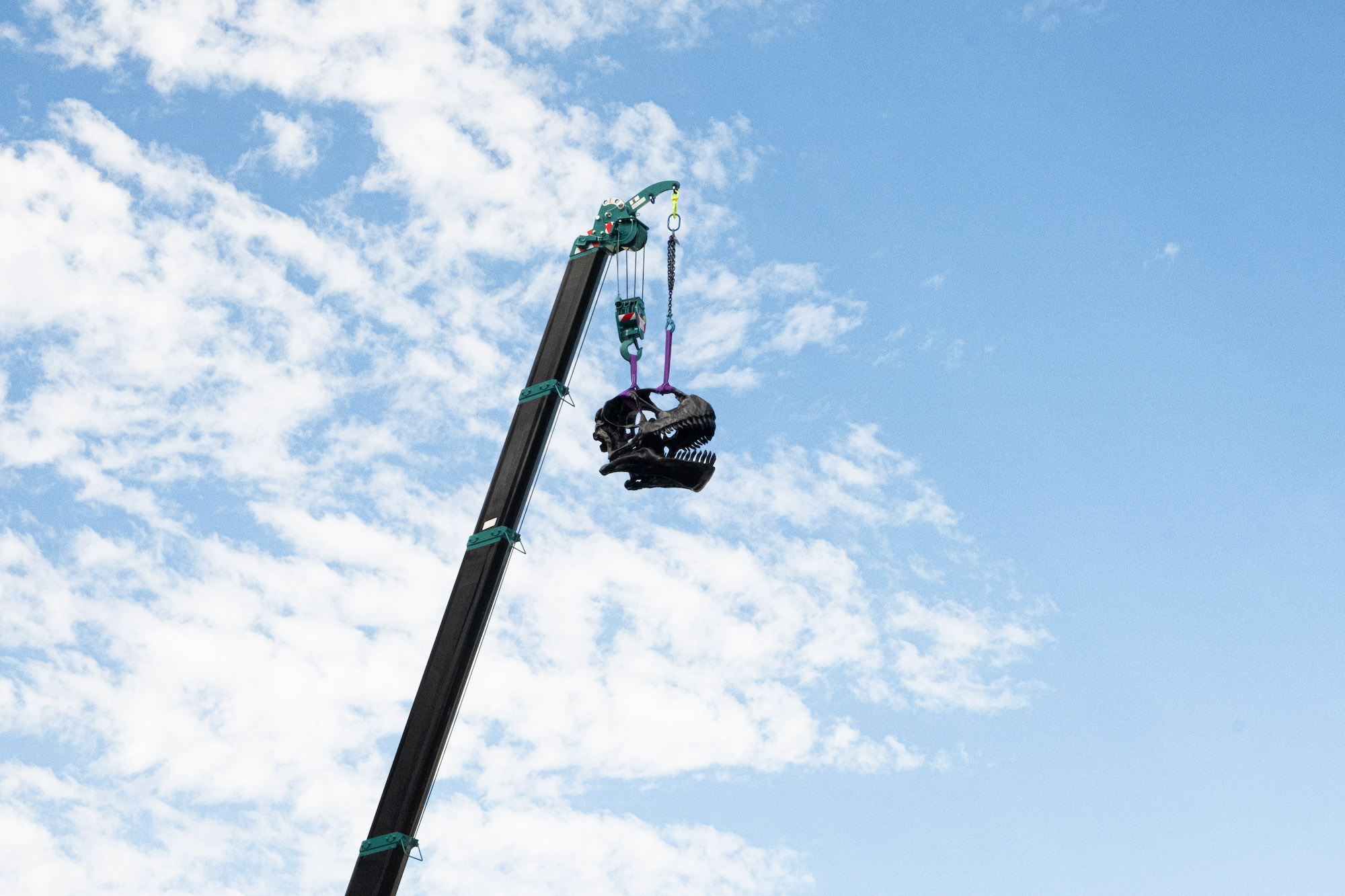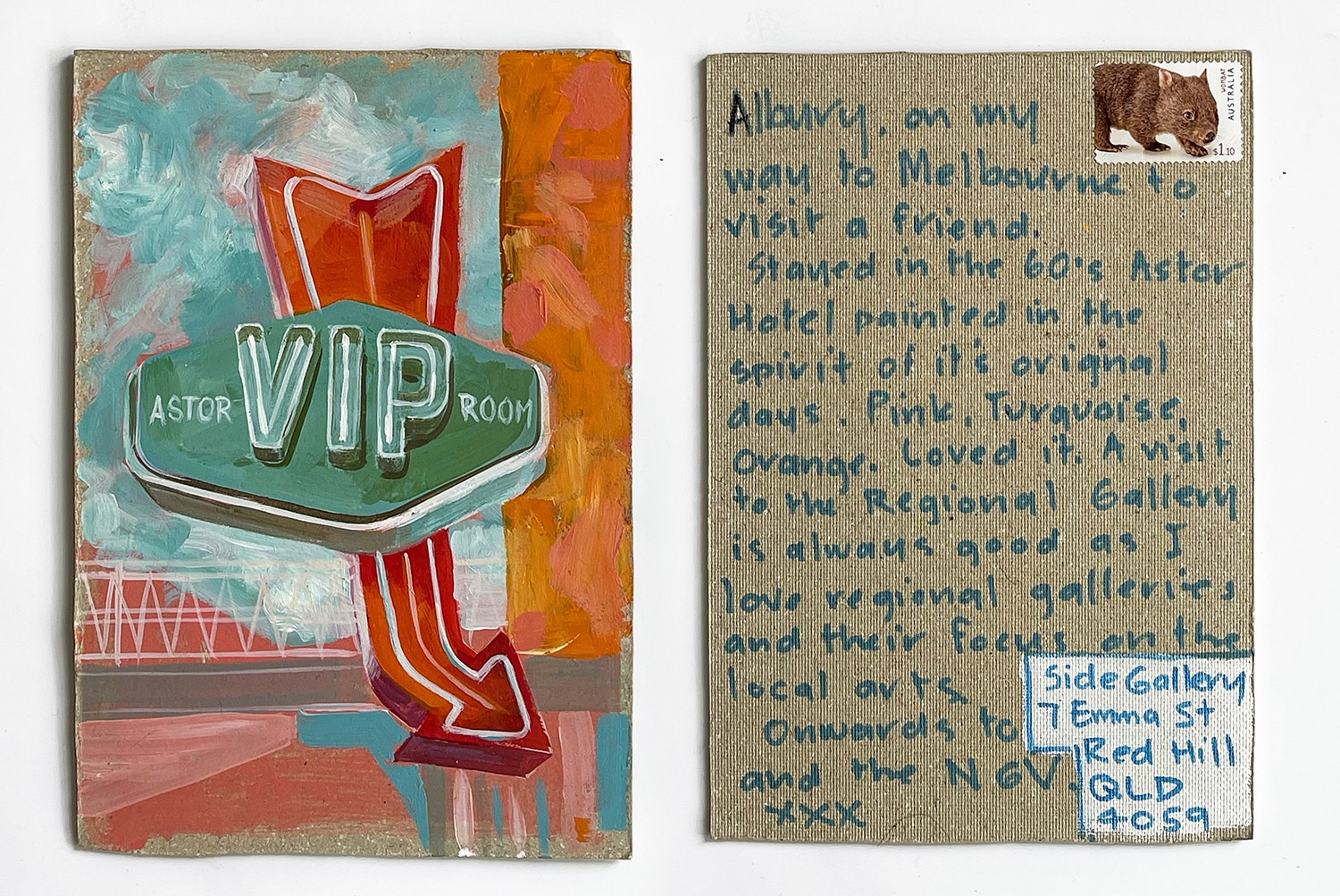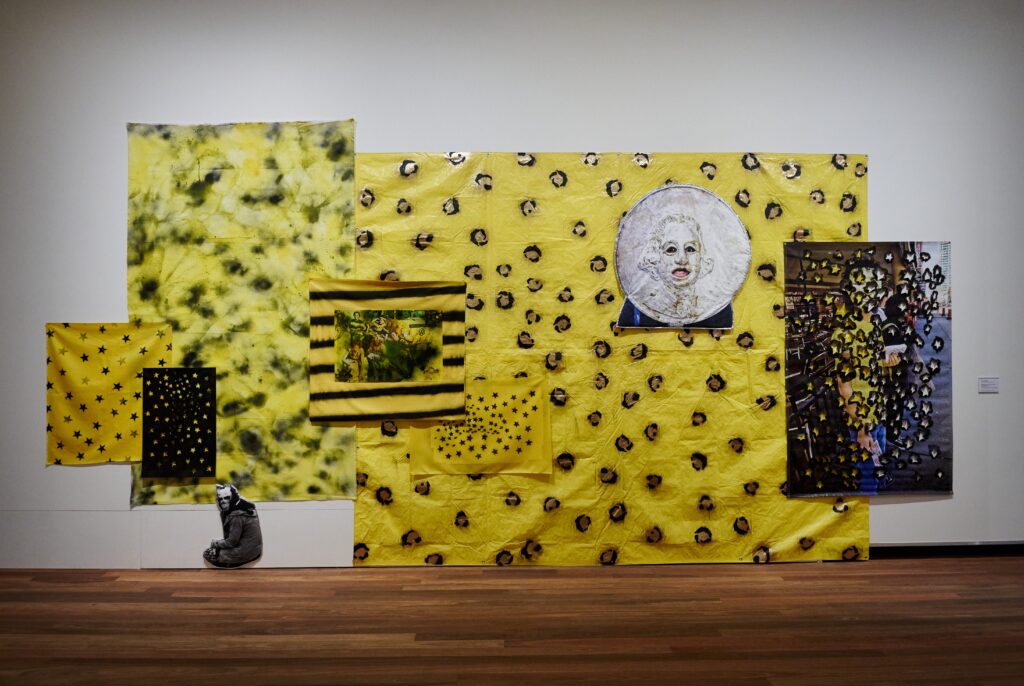
Jemima Wyman is a Palawa artist who lives and works between Brisbane/Meanjin and Los Angeles, USA. Her practice encompasses performance, video, installation, collage, photography and painting to explore surface design and masking as a means of visual resistance: “specifically camouflage as a formal, social and political strategy in negotiating identity.”[1] Her works draw upon her own digital archive of global protest images, dubbed the MAS-archive, which she has compiled since 2008.[2]
Wyman’s Crisis Patterns at Artspace Mackay doubles as a mid-career survey and a kind of homecoming, carrying with it the anticipation and self-reflections that mark the return to the place of your childhood. One of the region’s most renowned creative expats, Wyman describes her youth, and her mother in particular, as informative to her later practice: “My parents were hippies and visionaries. Though we never went to museums or saw art, my experience growing up in Mackay was psychedelic.”[3] In an artist talk she expanded, describing her mother’s eclectic decorating style and a kitchen decoupaged in fashion and architectural pages. This is both a formative influence both on Wyman’s practice and the exhibition itself, with visitors drawn on entry to Flourish [4]… [abridged title], a kaleidoscopic wallpaper in yellow,
amber and black hues.
Crisis Patterns divides Artspace Mackay’s main gallery into three distinct spaces. Moving through the first ‘room’, the viewer begins their journey with Flourish 10… [abridged title] and Flourish 9… [abridged title], works that appear like William Morris patterns from afar, with closer inspection revealing their meticulous photo-collage construction. Drawing on the MAS-archive, each work from Flourish acts as a record of protest and activist activity from the COVID-19 years; between fungi, moth wings, and petals, are plague doctor masks, painted women, and signs heralding the end of the world. The sheer visual volume contained within these works are experienced by the eye as an optical illusion or mirage; camouflage patterns from both the natural and manmade worlds coalesce in a conversation of aposematic colouration. Wyman describes her interest at the time in the Yellow Vest movement and the increasing use of yellow and black by protest movements across the world. In nature, yellow and black acts as a warning to repel predators; the ultimate sign of ‘don’t muck with me’. In protest, the colours speak directly to oppositional forces as a warning of the activists’ collective strength, and their cause’s anticipated crisis; be it war, oppression, or climate change.
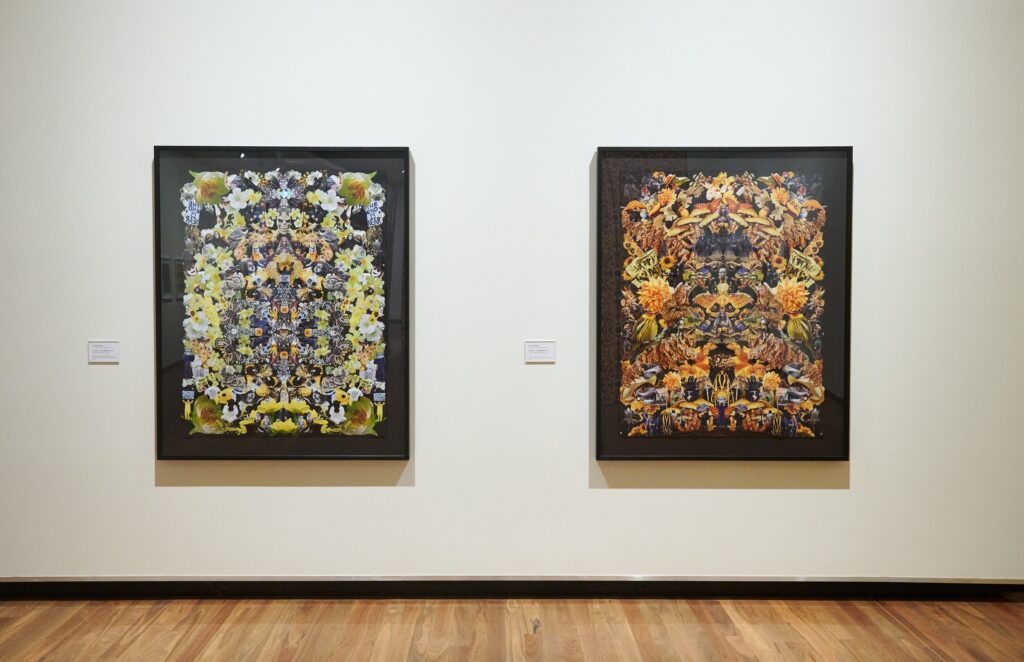
The yellow and black theme continues with Deepface and Cautionary signs… [abridged title], an installation with painted photographs, photographic vinyl, a spray-painted tarp, painted fabric and custom printed fabric. Here, Wyman departs from the precision of cut photographic images to explore the more ephemeral and gestural aesthetics of the street. The jaguar spots painted on the body of a protestor in Flourish 9… [abridged title] are here spraypainted on a tarp at scale, and stars appear slashed into a printed photograph of a masked activist protesting Scientology. The contrast is a playful and deliberate introduction to Wyman’s more architectonic explorations of camouflage and surface design.
In the second ‘room’ of the exhibition, viewers enter Wyman’s smoke and haze works. Smoke is a form of camouflage, with the etymology of the word itself deriving from the French camouflet, ‘a whiff of smoke in the face.’ It is also an ephemeral body and political mask deployed by both police/military and civilians in response to protest. Each of the works’ extended titles document this potentiality, chronicling their photographic source: Molotov cocktails in an anti-government protest, burning police cars at a George Floyd protest in Philadelphia, smoke bombs, flares, fireworks and more. In Haze 5/6… [abridged title] Wyman prints a collage of smoke on a chiffon curtain or partition, an act that returns a fleeting form of camouflage to a fixed textile design. The work also points to smoke’s more architectural form and ability to divide contested space.
While smoke and haze are forms of camouflage in protest, for many they are also a symptom of disaster and a climate in distress. In Haze 1… [abridged title] this perspective feels particularly potent, with its gradation of white, lemon yellow, orange, reds and thundercloud blacks. During her artist talk at Artspace Mackay, Wyman recollected creating the smoke works during the COVID-19 lockdowns and Californian wildfires in Los Angeles, reflecting that she could smell smoke as she cut and assembled these collages. While the accompanying Billow works largely share the same unfixed perspective [4] , Haze 1… departs from the mandala-type patterning of these other works and opts for something far more reminiscent of a landscape on fire.[5] The result is unsettling, which is even more amplified as one reads through the
title’s long list of protest and conflict.
In a new set of works commissioned for the Mackay Regional Council Art Collection, Wyman builds upon these smoke works with a set of cloud ceiling papers, with one such pattern applied to the gallery’s bathroom corridor. Combining watercolour and photographic collage, the Cloud Conscience (2024) series is reminiscent of ceiling surface design in European art history, and the Italian Renaissance in particular.[6] Watercolour as a medium was often used in the Renaissance for artworks that documented and interpreted the natural world [7], and in this way these new, almost mosaic cloud works have a synergy with the earlier Flourish works with their contrast between the natural and human worlds.
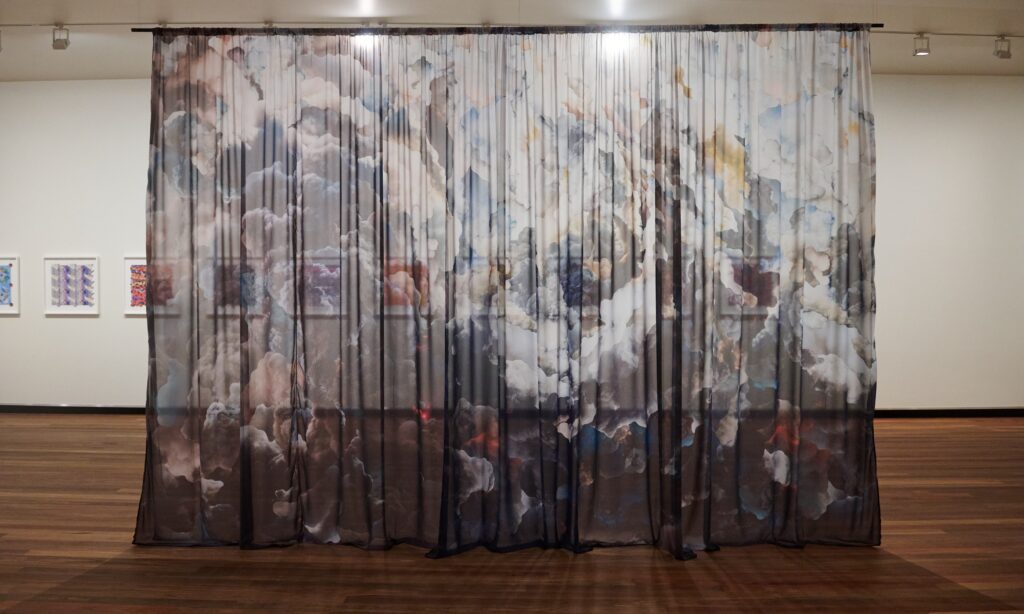
The final ‘room’ builds upon the relationship between camouflage and textile with quilted works and wallpaper, including a collaboration with the artist’s mother, Glenda Wyman. Here the tension between the ‘domestic’ (textiles) and the ‘public’ (protest), and their gendered connotations are teased. As Wyman herself acknowledges, the supposed ‘women’s craft’ of patterns and textile design are essential to camouflage and modern warfare, The artist book Propaganda Textiles (2017) acts as a lens for the audience to see this functional and architectonic potential of Wyman’s surface patterns.[8]
An ever prescient and visually dynamic exhibition, Crisis Patterns sits in conversation with Artspace’s two other exhibitions by Trawlwoolway and Laremairremener artist Mandy Quadrio (a former resident of Mackay) and Bidjara, Ghungalu and Garingbal artist Kate Harding (a Mackay local). This considered curatorial direction provides yet another way of viewing an exhibition that defies a single perspective. Through humour, playful observation, and at times the flattening and manipulation of perspective, Jemima Wyman’s survey positions the artist as both the chronicler and curator, an eyewitness and provocateur. With her latest Cloud Conscience commission and recent Atmospheric Disturbances exhibition at Sullivan+Strumpf, Wyman proves that city streets set the stage for an ever-evolving tug-of-war of visual culture.
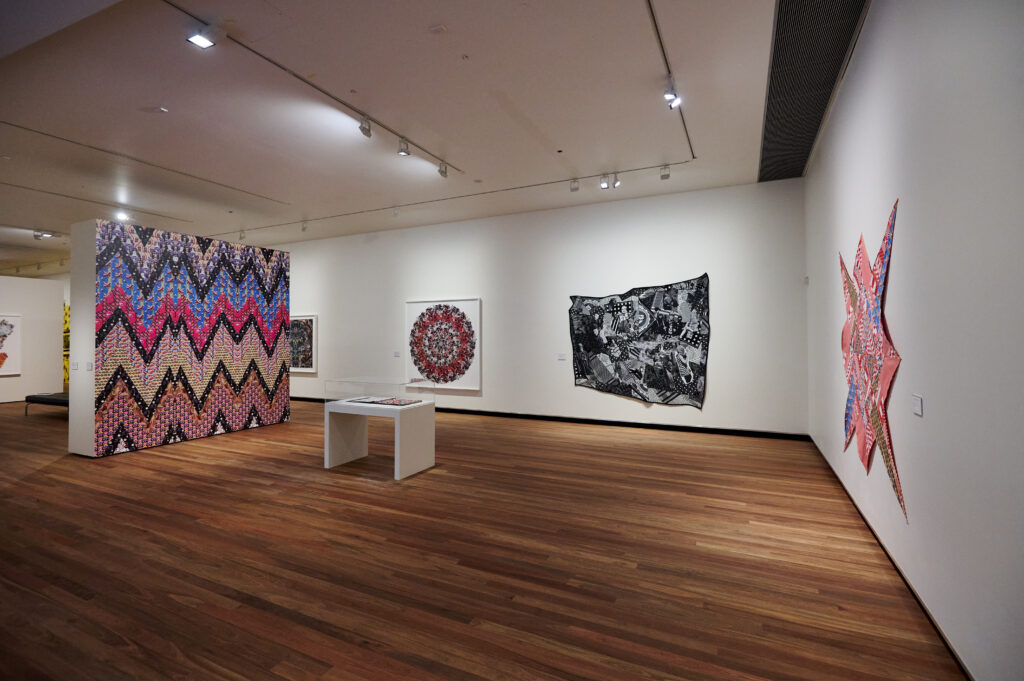
[1] Jemima Wyman | PHOTO 2024, viewed 24 October 2024.
[2] J Sorkin, 2024, ‘Figure/Ground: The Art of Jemima Wyman’, in Jemima Wyman: Crisis Patterns,
Artspace Mackay, Mackay, p.5.
[3] Robert Leonard, 2024, ‘Jemima Wyman: Psychedelic Protest’, Town Hall: Institute of Modern Art, pp.
20–22.
[4] Vivian Ziherl, 2024, ‘Embrace Without Capture: Haze, clouds and smoke in Jemima Wyman’s “Deep
Surface”’, in Jemima Wyman: Crisis Patterns, Artspace Mackay, Mackay, p. 13.
[5] Ziherl, 11.
[6] Ziherl, 10.
[7] “About the Renaissance Watercolours display n.d.,” Victoria and Albert Museum.
[8] Ziherl, 13.
Katelyn-Jane Dunn is a photographic artist and writer living on Yuwi country (Mackay, Queensland). She has previously written for the Griffith University Art Collection, Spiro Grace Art Rooms, and the Jewellery and Metalsmiths Group of Australia, Queensland.

